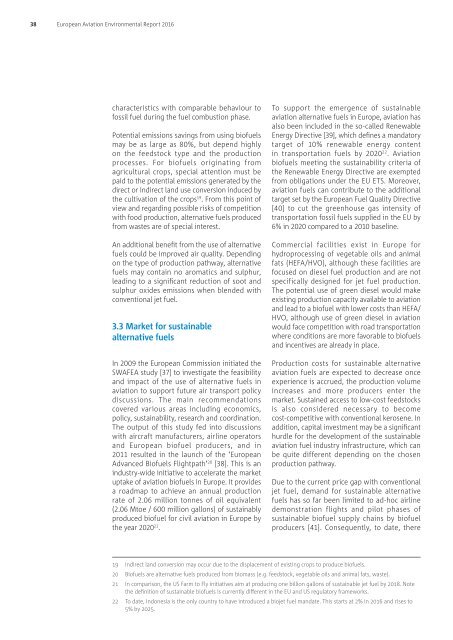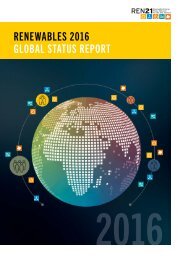European Aviation Environmental Report 2016
1nTl7nR
1nTl7nR
Create successful ePaper yourself
Turn your PDF publications into a flip-book with our unique Google optimized e-Paper software.
38 <strong>European</strong> <strong>Aviation</strong> <strong>Environmental</strong> <strong>Report</strong> <strong>2016</strong><br />
characteristics with comparable behaviour to<br />
fossil fuel during the fuel combustion phase.<br />
Potential emissions savings from using biofuels<br />
may be as large as 80%, but depend highly<br />
on the feedstock type and the production<br />
processes. For biofuels originating from<br />
agricultural crops, special attention must be<br />
paid to the potential emissions generated by the<br />
direct or indirect land use conversion induced by<br />
the cultivation of the crops 19 . From this point of<br />
view and regarding possible risks of competition<br />
with food production, alternative fuels produced<br />
from wastes are of special interest.<br />
An additional benefit from the use of alternative<br />
fuels could be improved air quality. Depending<br />
on the type of production pathway, alternative<br />
fuels may contain no aromatics and sulphur,<br />
leading to a significant reduction of soot and<br />
sulphur oxides emissions when blended with<br />
conventional jet fuel.<br />
3.3 Market for sustainable<br />
alternative fuels<br />
In 2009 the <strong>European</strong> Commission initiated the<br />
SWAFEA study [37] to investigate the feasibility<br />
and impact of the use of alternative fuels in<br />
aviation to support future air transport policy<br />
discussions. The main recommendations<br />
covered various areas including economics,<br />
policy, sustainability, research and coordination.<br />
The output of this study fed into discussions<br />
with aircraft manufacturers, airline operators<br />
and <strong>European</strong> biofuel producers, and in<br />
2011 resulted in the launch of the ‘<strong>European</strong><br />
Advanced Biofuels Flightpath’ 20 [38]. This is an<br />
industry‐wide initiative to accelerate the market<br />
uptake of aviation biofuels in Europe. It provides<br />
a roadmap to achieve an annual production<br />
rate of 2.06 million tonnes of oil equivalent<br />
(2.06 Mtoe / 600 million gallons) of sustainably<br />
produced biofuel for civil aviation in Europe by<br />
the year 2020 21 .<br />
To support the emergence of sustainable<br />
aviation alternative fuels in Europe, aviation has<br />
also been included in the so‐called Renewable<br />
Energy Directive [39], which defines a mandatory<br />
target of 10% renewable energy content<br />
in transportation fuels by 2020 22 . <strong>Aviation</strong><br />
biofuels meeting the sustainability criteria of<br />
the Renewable Energy Directive are exempted<br />
from obligations under the EU ETS. Moreover,<br />
aviation fuels can contribute to the additional<br />
target set by the <strong>European</strong> Fuel Quality Directive<br />
[40] to cut the greenhouse gas intensity of<br />
transportation fossil fuels supplied in the EU by<br />
6% in 2020 compared to a 2010 baseline.<br />
Commercial facilities exist in Europe for<br />
hydroprocessing of vegetable oils and animal<br />
fats (HEFA/HVO), although these facilities are<br />
focused on diesel fuel production and are not<br />
specifically designed for jet fuel production.<br />
The potential use of green diesel would make<br />
existing production capacity available to aviation<br />
and lead to a biofuel with lower costs than HEFA/<br />
HVO, although use of green diesel in aviation<br />
would face competition with road transportation<br />
where conditions are more favorable to biofuels<br />
and incentives are already in place.<br />
Production costs for sustainable alternative<br />
aviation fuels are expected to decrease once<br />
experience is accrued, the production volume<br />
increases and more producers enter the<br />
market. Sustained access to low‐cost feedstocks<br />
is also considered necessary to become<br />
cost‐competitive with conventional kerosene. In<br />
addition, capital investment may be a significant<br />
hurdle for the development of the sustainable<br />
aviation fuel industry infrastructure, which can<br />
be quite different depending on the chosen<br />
production pathway.<br />
Due to the current price gap with conventional<br />
jet fuel, demand for sustainable alternative<br />
fuels has so far been limited to ad‐hoc airline<br />
demonstration flights and pilot phases of<br />
sustainable biofuel supply chains by biofuel<br />
producers [41]. Consequently, to date, there<br />
19 Indirect land conversion may occur due to the displacement of existing crops to produce biofuels.<br />
20 Biofuels are alternative fuels produced from biomass (e.g. feedstock, vegetable oils and animal fats, waste).<br />
21 In comparison, the US Farm to Fly initiatives aim at producing one billion gallons of sustainable jet fuel by 2018. Note<br />
the definition of sustainable biofuels is currently different in the EU and US regulatory frameworks.<br />
22 To date, Indonesia is the only country to have introduced a biojet fuel mandate. This starts at 2% in <strong>2016</strong> and rises to<br />
5% by 2025.



